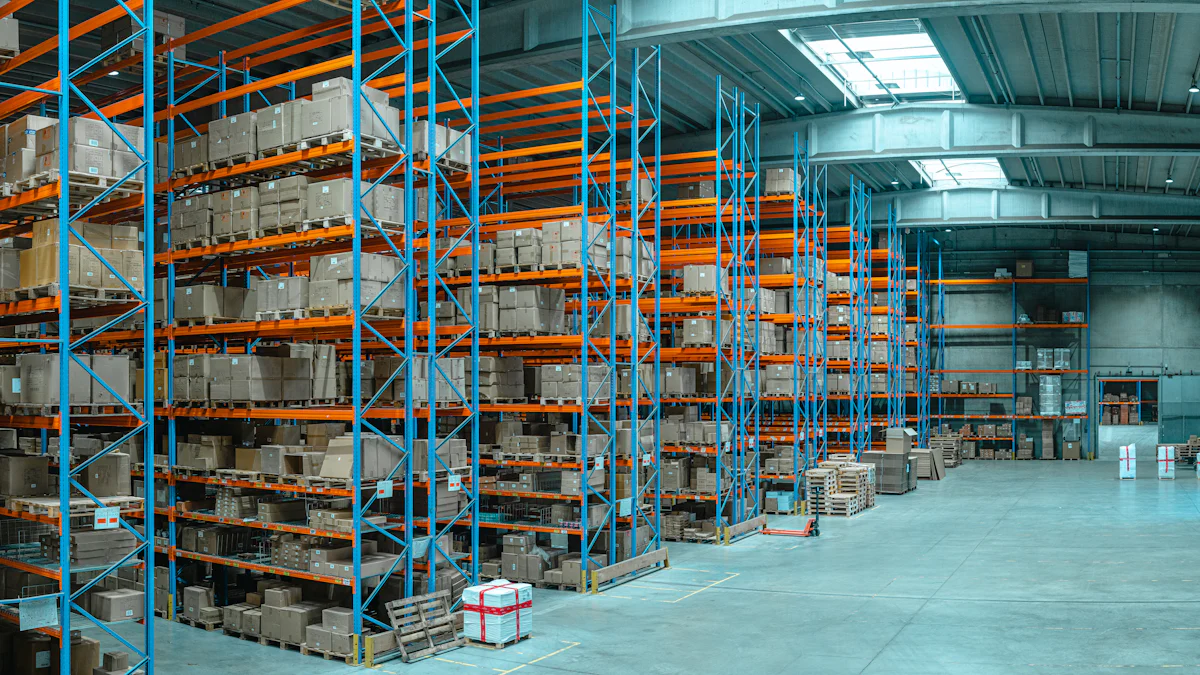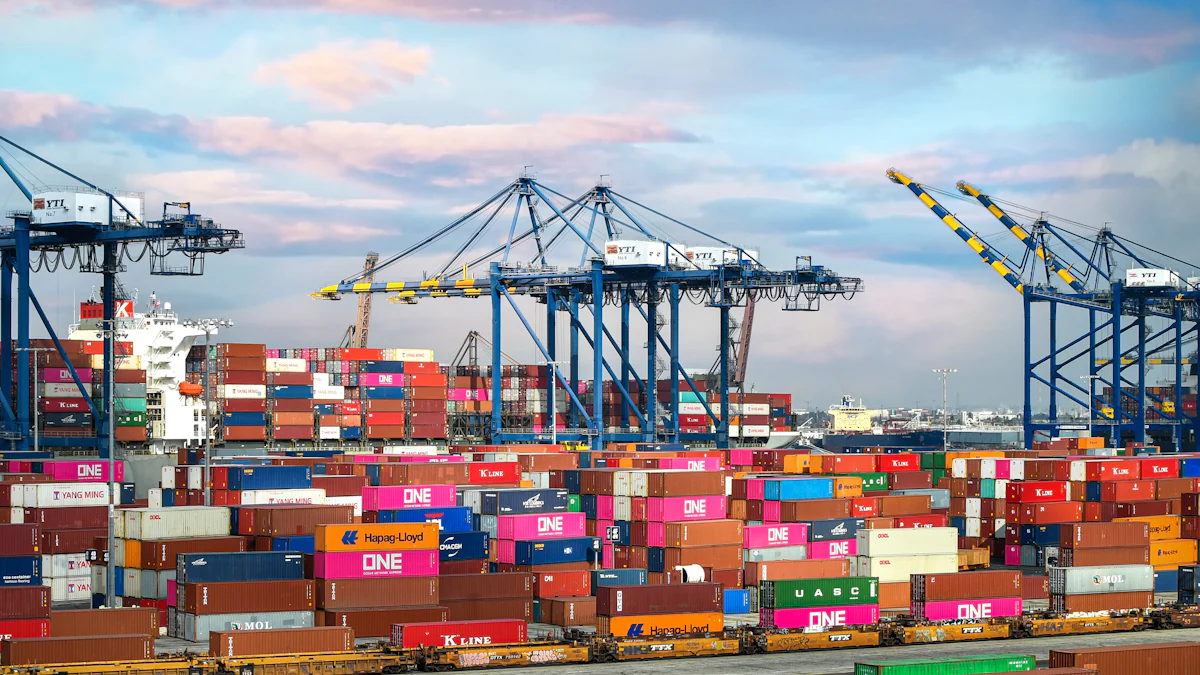2024 Logistics Industry: A Comprehensive Guide

In the modern business world, Logistics industry plays a pivotal role as a pillar of operational success. As businesses navigate the dynamic landscape of 2024, understanding the evolving trends and technological advancements within the logistics industry is paramount. This comprehensive guide offers an insightful overview of the key components shaping logistics in 2024, from automation to sustainability practices. By delving into the purpose and scope of this guide, businesses can leverage logistics to optimize their operations and stay ahead in a competitive market.
Key Trends and Technological Advancements

The Logistics industry in 2024 is witnessing a transformative shift driven by cutting-edge technologies. Let's explore the forefront of innovation shaping logistics operations.
Automation in Logistics
Role of robotics and automated systems
Robotics and automated systems are revolutionizing the Logistics industry, streamlining processes, and enhancing operational efficiency.
According to the MHI Annual Industry Report (2023), nearly 80% of businesses are planning to invest in integrating robotics and automation technologies for competitive advantage.
Benefits and challenges of automation
The integration of automation brings forth numerous benefits such as increased productivity, reduced errors, and optimized resource allocation.
However, businesses also face challenges like initial high costs, technical complexities, and workforce adaptation requirements.
Internet of Things (IoT)
IoT applications in logistics
The Internet of Things (IoT) is playing a pivotal role in logistics by enabling real-time tracking, monitoring, and data-driven decision-making.
As highlighted by SCM Research, IoT enhances visibility, efficiency, and responsiveness throughout the supply chain.
Impact on efficiency and tracking
IoT applications enhance operational efficiency by providing insights into inventory levels, equipment conditions, and delivery status.
By leveraging IoT technologies, businesses can optimize routes, reduce delays, and improve overall customer satisfaction.
Artificial Intelligence (AI)
AI-driven decision making
Artificial Intelligence (AI) is empowering logistics companies with intelligent decision-making capabilities based on data analysis and predictive algorithms.
DHL Freight Connections emphasizes that AI technologies optimize stock levels and contribute to sustainable logistics practices.
Predictive analytics and demand forecasting
AI facilitates accurate demand forecasting through predictive analytics models that consider historical data trends and market dynamics.
By harnessing AI for demand forecasting, businesses can anticipate consumer needs, prevent stockouts, and enhance inventory management.
Digitalization and Big Data
Digital twins and their applications
In the realm of Logistics industry, embracing digital twins has become a strategic imperative for optimizing operations. These virtual replicas of physical assets enable real-time monitoring, predictive maintenance, and performance simulations. By leveraging digital twins, businesses can enhance operational visibility, streamline processes, and proactively address potential disruptions.
Furthermore, the role of big data in Logistics industry optimization cannot be overstated. The vast amounts of data generated across supply chains provide valuable insights for decision-making and strategy formulation. Analyzing big data allows businesses to identify trends, forecast demand accurately, and improve overall operational efficiency.
Incorporating digitalization and big data analytics into logistics practices empowers organizations to adapt swiftly to market dynamics, mitigate risks effectively, and deliver exceptional customer experiences through streamlined operations.
Transportation
Innovations in Freight Transport
Autonomous vehicles and drones
Autonomous vehicles and drones are revolutionizing the transportation sector, enhancing delivery speed and efficiency.
By utilizing autonomous vehicles, companies can optimize routes, reduce human errors, and ensure timely deliveries.
Drones play a crucial role in last-mile deliveries, especially in urban areas where access can be challenging.
Electric and sustainable transport options
The shift towards electric and sustainable transport options is reshaping the logistics landscape by reducing carbon emissions.
Companies embracing electric vehicles contribute to environmental sustainability while meeting regulatory requirements.
Sustainable transport solutions not only benefit the environment but also improve operational cost-effectiveness.
Supply Chain Management
Digital Supply Chains
Integration of digital tools
Implementation of advanced digital tools is revolutionizing supply chain management, enhancing operational efficiency and visibility.
Companies are integrating cutting-edge technologies such as AI-driven software and IoT networks to streamline processes and optimize resource allocation.
The utilization of digital tools enables real-time data tracking, predictive analytics, and automated decision-making for agile supply chain operations.
Benefits of real-time data
Real-time data in supply chain management provides immediate insights into inventory levels, demand fluctuations, and delivery statuses.
By leveraging real-time data analytics, businesses can make informed decisions promptly, anticipate market trends, and respond swiftly to changing demands.
The integration of real-time data systems enhances supply chain responsiveness, reduces lead times, and improves overall customer satisfaction.
Inventory Management
Advanced inventory tracking systems
Advanced inventory tracking systems leverage RFID technology and barcode scanning to monitor stock levels accurately across the supply chain.
These systems facilitate efficient inventory control, minimize stock discrepancies, and enable timely replenishment strategies.
By implementing advanced inventory tracking systems, businesses can optimize warehouse operations, reduce carrying costs, and prevent stockouts effectively.
Just-in-time (JIT) inventory strategies
Just-in-time (JIT) inventory strategies focus on minimizing excess inventory by synchronizing production with demand patterns.
JIT principles emphasize lean practices, efficient logistics coordination, and strategic supplier partnerships for seamless material flow.
Adopting JIT inventory strategies enables businesses to reduce storage costs, enhance production flexibility, and improve overall supply chain efficiency.
Fourth Party Logistics (4PL)
Growth and significance of 4PL
The Fourth Party Logistics (4PL) model is gaining prominence in modern supply chains as businesses seek comprehensive logistics solutions.
4PL providers offer end-to-end supply chain management services that encompass planning, execution, monitoring, and optimization functions.
With the growth of global trade complexities, the significance of 4PL lies in its ability to orchestrate multiple logistics partners seamlessly for enhanced operational performance.
Benefits for businesses
Cost Efficiency: Outsourcing logistics to a 4PL provider reduces operational costs through optimized transportation routes and resource utilization.
Scalability: Businesses benefit from scalable logistics solutions tailored to their specific needs without heavy investments in infrastructure.
Operational Flexibility: 4PL providers offer dynamic solutions that adapt to changing market conditions and business requirements swiftly.
Risk Mitigation: By entrusting logistics operations to experts in the field, businesses mitigate risks associated with disruptions or inefficiencies effectively.
Incorporating Fourth Party Logistics (4PL) into supply chain management strategies empowers businesses with comprehensive logistical support tailored to meet evolving market demands efficiently.
Sustainability in Logistics

Green Logistics Practices
Reducing carbon footprint
Implementing energy-efficient technologies and optimizing transport routes can significantly decrease emissions.
Utilizing eco-friendly packaging materials and promoting sustainable practices contribute to environmental conservation.
Collaborating with green-certified suppliers ensures adherence to environmentally friendly standards throughout the supply chain.
Circular Economy
Recycling and reuse in logistics
Establishing recycling programs for packaging materials minimizes waste and supports a circular economy model.
Repurposing returned goods or excess inventory reduces landfill accumulation and promotes resource sustainability.
Partnering with recycling facilities enables the transformation of waste materials into reusable resources, fostering a closed-loop system.
Impact on supply chain sustainability
Embracing circular economy principles enhances resource efficiency and reduces the ecological footprint of logistics operations.
Integrating reverse logistics processes for product returns facilitates material recovery and minimizes environmental impact.
Engaging in sustainable sourcing practices cultivates a responsible supply chain ecosystem focused on long-term environmental stewardship.
Regulatory Aspects
Compliance with CMR
Overview of CMR regulations
Companies operating in the logistics industry are mandated to comply with the Convention on the Contract for the International Carriage of Goods by Road (CMR) regulations.
The CMR regulations establish a framework for international logistics operations, ensuring standardized practices and legal compliance across borders.
Impact on international logistics
Adhering to CMR regulations is crucial for facilitating seamless international logistics operations and minimizing legal risks.
By complying with CMR standards, businesses can enhance operational efficiency, mitigate potential disputes, and foster trust among global partners.
Market Reports and Analysis
Key market trends and statistics
Market reports indicate a growing emphasis on sustainability practices within the logistics industry, influencing strategic decision-making and operational frameworks.
Statistical data reveals an increasing adoption of eco-friendly transport solutions and circular economy models to align with evolving consumer preferences and regulatory requirements.
Regional market insights
Regional market analyses highlight varying approaches to sustainability in logistics across different geographical areas, reflecting diverse regulatory landscapes and industry priorities.
Insights from market reports underscore the importance of adapting logistics strategies to regional nuances, fostering innovation, and driving sustainable growth in a competitive marketplace.
Summarize the pivotal advancements in logistics technology, emphasizing automation, IoT applications, and AI-driven decision-making.
Envision a future where sustainable practices and digitalization redefine operational strategies in the logistics industry.
Businesses must adapt swiftly to technological disruptions to maintain competitiveness and enhance supply chain efficiency.
Embrace innovation, prioritize sustainability, and foster collaboration for sustained success in the evolving logistics landscape.
See Also
Best 5 Logistics Courses for 2024
Latest Updates on Sea Freight Logistics in 2024
Exploring Future Innovations in Logistics Technology
Revealing the Best Global Logistics Firms Guide
Maximizing Savings in Logistics Costs: A Comprehensive Guide
